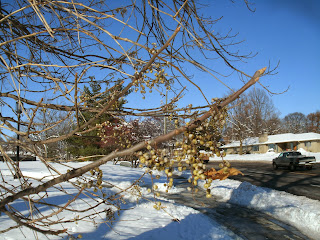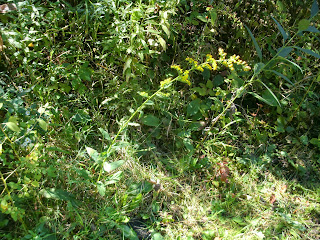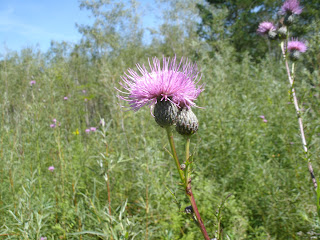Tuesday, December 31, 2013
Mural at 3rd & Romig St.
Everybody looking at smartphone. The inaccuracy of this is, it shows everybody standing still but not walking or driving.
http://www.cnn.com/2012/10/03/tech/smartphone-zombie-apocalypse-comments/
Wednesday, December 25, 2013
Red-tailed hawk along Wabash Heritage Trail
On the Wabash River Heritage Trail near downtown Lafayette, I noticed this red-tailed hawk (Buteo jamaicensis) sitting in a bush. Unusually close by and it didn't fly away. Then I saw that he had caught a rabbit and wasn't finished with it so he sat there despite my presence. Picture Dec. 24, 2013.
Previous post on Buteo jamaicensis:
Previous post on Buteo jamaicensis:
Wabash River December 2013
Wabash River at the pedestrian bridge Lafayette, Dec. 18, 2013. About 4 inches of snow had fallen a few days before.
Link to Wabash River levels
Tuesday, December 24, 2013
Poison ivy berries
Poison ivy berries (Toxicodendron radicans) in winter,
The poison ivy vine is climbing up this cottonwood tree on the Purdue campus. This would be an easy place to visit if you want to learn what poison ivy looks like. It is along Northwestern Avenue just a bit south of Cherry Lane. The cottonwood tree behind it has a trumpet creeper vine on it (Campsis radicans). Pictures taken Dec. 18, 2013.
Link to Toxicodendron radicans:
Link to previous post on Toxicodendron radicans:
Friday, December 20, 2013
A place for shelf fungus
At the west end of the pedestrian bridge. The top half of this ornamental pear tree (Pyrus calleryana) was blown over in the November windstorm. These kind of trees have weak wood and often get damaged by wind and ice. This will make a good fungus garden if the Park Department will leave it alone.
Photo taken Nov. 28, 2013.
Link to previous post on Pyrus calleryana:
Photo taken Nov. 28, 2013.
Link to previous post on Pyrus calleryana:
Sunday, November 10, 2013
Nine leaves of Puttyroot Orchid
The leaves of puttyroot orchid (Aplectrum hyemale) are just now emerging from the ground. They will lay down flat on the ground and persist as green leaves throughout the winter. This is in the woods at Celery Bog Park, November 7, 2013.
Link to previous post on these puttyroot orchids:
Wild mustard and lamb's quarters along the new roadside
Yellow flowers of wild mustard (Brassica) and the red of lamb's quarters (Chenopodium album) along the new road west of town, Lamb's quarters are normally green like most other plants but now they have turned red with autumn coloration just like the leaves on the trees. November 3, 2013.
:Link to Chenopodium album:
Link to wild mustard:
Monday, November 4, 2013
Chasmanthium latifolium
Chasmanthium latifolium, also called inland oat grass, at Clegg Gardens, on the bank of the Wildcat Creek. Picture taken Oct. 29, 2013.
Link to Chasmanthium latifolium:
Link to Chasmanthium latifolium:
Sunday, October 13, 2013
Great Blue Heron
A great blue heron (Ardia herodias) stalks its prey at the pond in front of University Place on Lindberg Road. Pictures taken October 10, 2013.
Link to previous post on great blue heron:
Link to another post on great blue heron:
Dryad's saddle mushroom on a sugar maple stump
Dryad's saddle (Polyporus squamosus) appears all up and down this big sugar maple stump in Celery Bog Park. The plants to the side of the stump are pokeweed (Phytolacca americana). Picture taken October 10, 2013.
Link to previous post about this stump:
Link to Dryad's saddle:
Link to previous post about this stump:
Link to Dryad's saddle:
Riddell's goldenrod
Riddell's goldenrod, at the fen at Prophetstown State Park. Picture taken Sept. 25, 2013. Some sources say that this goldenrod has been reclassified as Oligoneuron riddellii but in the Flora of North America treatment it remains Solidago riddellii so I am going with that.
Link to FNA treatment of Solidago riddellii:
Link to Riddell's Goldenrod:
Link to Riddell's Goldenrod:
Link to FNA treatment of Solidago riddellii:
Link to Riddell's Goldenrod:
Link to Riddell's Goldenrod:
Swamp goldenrod
Swamp goldenrod (Solidago patula) at the entrance to the fen at Prophetstown State Park. Picture taken Sept. 25, 2013.
Link to Solidago patula:
Link to Solidago patula:
Thursday, September 26, 2013
Shining aster
The shining aster of wetlands. At Prophetstown fen, at the state park. Tough to get a good scientific name on this one, I'll call it Aster firmus. Picture taken Sept. 25, 2013.
Link to Aster firmus:
another link:
Link to Aster firmus:
another link:
Tuesday, September 24, 2013
Prenanthes
Prenanthes, in Moyer-Gould Woods, Carroll County. Probably Prenanthes altissima.
Picture taken Sept;. 22, 2013.
Link to Prenanthes altissima:
Link to Prenanthes altissima:
Link to Prenanthes altissima:
Link to Moyer-Gould Woods:
Dyer's Polypore and Zigzag Goldenrod
The mushroom at the base of this white oak tree is a dyer's polypore (Phaeolus schweinitzii). It popped up to surround the zigzag goldenrod (Solidago flexicaulis) in the middle of the picture. The big dyer's polypore section in the left of the picture is concave enough that it is holding water like a birdbath. Green algae is growing in the water. The plant on the right is Lonicera maackii. This white oak tree is in Moyer-Gould Woods in Carroll County, on high ground at the edge of a ravine. A spring emerges directly below the tree keeping it perpetually watered. Along with the goldenrod the polypore surrounds a dead stem of Osmorhiza. Picture taken September 22, 2013.
Link to Phaeolus schweinitzii:
Link to Phaeolus schweinitzii:
Link to Phaeolus schweinitzii:
Link to Solidago flexicaulis:
Link to previous post on Lonicera maackii:
Link to Osmorhiza:
Link to Moyer-Gould Woods:
Link to Phaeolus schweinitzii:
Link to Phaeolus schweinitzii:
Link to Phaeolus schweinitzii:
Link to Solidago flexicaulis:
Link to previous post on Lonicera maackii:
Link to Osmorhiza:
Link to Moyer-Gould Woods:
Thursday, September 19, 2013
Nodding Bur Marigold
Yellow flowers of nodding bur marigold (Bidens cernua) at the west edge of Coot Slough, at Celery Bog Park. Pictures taken September 17, 2013.
Link to Bidens cernua:
Link to Bidens cernua:
Link to Bidens cernua:
Tuesday, September 17, 2013
Thistle at Indianapolis
A thistle rosette on the north side of 207 N Delaware St., Indianapolis. Compare to Carduus nutans. September 15, 2013.
Link to previous post on Carduus nutans:
Link to previous post on Carduus nutans:
Wednesday, September 11, 2013
Sneezeweed and Giant ragweed
The yellow flowers here are sneezeweed (Helenium autumnale) and the tall plants just beyond are giant ragweed (Ambrosia trifida). This is along the new Trail 3 at Prophetstown State Park. Further down this trail it turns into virtually a solid forest of giant ragweed. Picture taken September 7, 2013.
Link to previous post on common sneezeweed:
Link to giant ragweed:
Link to previous post on another kind of sneezeweed:
Kummerowia stipulacea
This is Kummerowia stipulacea, also called Korean lespedeza.
Growing at the edge of the roadside, Swisher Road on the approach to the bridge over I-65. Near the main entrance to Prophetstown State Park. Tippecanoe County, September 7, 2013.
Link to Kummerowia stipulacea:
Link to Kummerowia:
Link to Kummerowia:
Friday, September 6, 2013
A volunteer pumpkin
A cucurbit grows wild on the sandy bank of the Wabash River. Likely from a seed from somebody's garden, washed there in a flood. A very few spots of powdery mildew on the leaves. Near where the West Lafayette sewage treatment plant's outflow reaches the river. Picture taken Sept. 1, 2013.
Link to Cucurbita pepo:
Link to Cucurbita pepo:
Link to powdery mildew on Cucurbit:
Thursday, September 5, 2013
Boneset
Boneset (Eupatorium perfoliatum) at the fen at Prophetstown State Park. Picture taken Sept. 4, 2013.
Link to previous post on Eupatorium perfoliatum:
Link to Eupatorium perfoliatum:
Link to previous post on Eupatorium perfoliatum:
Link to Eupatorium perfoliatum:
Pedicularis lanceolata
Pedicularis lanceolata at the fen at Prophetstown State Park, Sept. 4, 2013. Pedicularis is now classified in the family Orobanchaceae and is parasitic on the other plant species near it.
Link to Pedicularis lanceolata:
Link to Pedicularis lanceolata:
Link to what a fen is:
Link to Pedicularis lanceolata:
Link to Pedicularis lanceolata:
Link to what a fen is:
Epilobium coloratum
This plant with the tiny white-pinkish 4-petaled flowers is Epilobium coloratum. At the fen at Prophetstown State Park. The yellow flowers are probably a Bidens or Coreopsis. Picture taken Sept. 4, 2013.
Link to Epilobium coloratum:
Link to Epilobium coloratum:
Link to Epilobium coloratum:
Link to Epilobium coloratum:
Swamp thistle
Swamp thistle (Cirsium muticum) at the fen at Prophetstown State Park. Picture taken Sept. 4, 2013.
Link to Cirsium muticum:
Link to Cirsium muticum:
Wednesday, September 4, 2013
Agalinis
Agalinis, at the fen at Prophetstown State Park. There are two species of Agalinis reported for Tippecanoe County, Agalinis purpurea and Agalinis tenuifolia. I am calling this Agalinis purpurea because of the short pedicels of the flowers.
Picture taken September 4, 2013.
Link to Agalinis purpurea:
Link to Indiana range of Agalinis purpurea:
Link to Agalinis tenuifolia:
Link to Indiana range of Agalinis tenuifolia:
Tuesday, September 3, 2013
Wild poinsettia and prairie tea
Wild poinsettia (Euphorbia dentata) in the middle of the picture. Another name for this plant is toothed spurge. Below the Euphorbia dentata is a carpet of prairie tea (Croton monanthogynus). At the trailhead to the Wabash River trail that is at North 9th St. near McAllister Park.
Link to previous post on Euphorbia dentata:
Link to Wabash River Heritage Trail:
Prairie tea (Croton monanthogynus) just north of downtown Lafayette. Both pictures taken Aug.11, 2013.
Link to previous post on Croton monanthogynus:
Link to previous post on Euphorbia dentata:
Link to Wabash River Heritage Trail:
Prairie tea (Croton monanthogynus) just north of downtown Lafayette. Both pictures taken Aug.11, 2013.
Link to previous post on Croton monanthogynus:
Monday, September 2, 2013
Bur cucumber tendrils
Tendrils of bur cucumber (Sicyos angulatus) get tightly wound up wherever they touch the plant that the bur cucumber is climbing over. This bur cucumber is climbing over a sunflower at the north wetland at Celery Bog Park near Cumberland Drive.
Link to previous post on bur cucumber:
These are new bur cucumber tendrils reaching to find a plant.to grab. If they touch something they will wind up to look like the tendrils in the top picture.
Link to previous post on the sunflowers in the background.
Pictures taken August 12, 2013.
Saturday, August 31, 2013
Cirsium discolor
Pasture thistle (Cirsium discolor) at Spinn Prairie, White County. The yellow flowers in the background are prairie-dock rosinweed (Silphium terebinthinaceum). Picture taken Aug. 21, 2013.
Link to Cirsium discolor:
Link to Cirsium discolor:
Link to Cirsium discolor:
Link to Silphium terebinthinaceum:
Link to Spinn Prairie:
Link to Cirsium discolor:
Link to Cirsium discolor:
Link to Cirsium discolor:
Link to Silphium terebinthinaceum:
Link to Spinn Prairie:
Lythrum alatum
Lythrum alatum at Spinn Prairie, White County. Picture taken August 21, 2013.
Link to Lythrum alatum:
Link to Lythrum alatum:
Link to Lythrum alatum:
Link to Lythrum alatum:
Link to Spinn Prairie:
Sonchus arvensis
Sonchus arvensis along roadside, Lafayette Road near 82nd St., Indianapolis, Marion County.
Pictures taken August 13, 2013.
Link to Sonchus arvensis:
Link to Sonchus arvensis:
Link to Sonchus arvensis:
Stone face at Williamsport Falls
At Willamsport Falls. Picture taken August 7, 2013.
Link to Williamsport Falls.
Link to Williamsport Falls.
Friday, August 30, 2013
Desmanthus illinoensis
Desmanthus illinoensis along the roadside, Lafayette Road where I-65 passes over, Boone County near Indianapolis. This is normally a prairie plant and this roadside is a odd place to find it. It is obviously growing wild but since it is close to I-65 it could have spread from a roadside wildflower planting along the interstate. Pictures taken August 24, 2013.
Link to previous post on Desmanthus illinoensis:
The setting here reminded me of this scene:
Tuesday, August 27, 2013
The persistence of prairie as Ruellia humilis
I spotted this plant along the roadside of US 52 a couple three miles SE of Lafayette. It was a bit different color than the familiar chicory common on roadsides. This is Ruellia humilis, a prairie plant. Once this was prairie land and this Ruellia is the last remnant of the prairie. I didn't see any other prairie plants anywhere nearby. All ther rest of the roadside for miles are the common plants of disturbed areas (some call them weeds). These two photos above taken Aug. 13, 2013 in Tippecanoe County.
Link to previous post on Ruellia humilis in a prairie remnant along US 52 in Benton County:
The photo directly above is Ruellia humilis at Prairie Creek Barrens in Daviess County, July 27, 2013.
Link to Ruellia humilis:
Monday, August 26, 2013
Bladder Campion
The Farm Heritage Trail runs in Boone County from Lebanon to
Thorntown and as far as Sugar Creek. It
has some interesting things botanically and this plant grows extensively along
this trail for miles. It’s a Silene,
probably Silene vulgaris, also known as bladder campion.
Although it could be Silene
cserei.
Silene cserei has been reported “along railroads” in Indiana, although not yet for Boone County.
The Farm Heritage Trail is the abandoned Indianapolis to Lafayette railroad.
Picture taken August 25, 2013.
Subscribe to:
Posts (Atom)














































